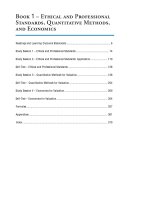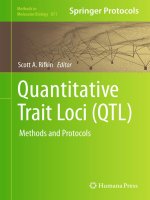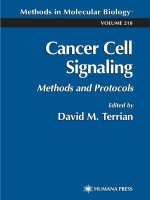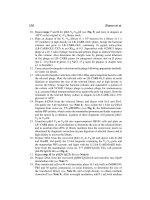E. coli Shiga Toxin Methods and Protocols doc
Bạn đang xem bản rút gọn của tài liệu. Xem và tải ngay bản đầy đủ của tài liệu tại đây (2.29 MB, 362 trang )
Humana Press
E. coli
Shiga Toxin Methods
and Protocols
Edited by
Dana Philpott
Frank Ebel
Humana Press
M E T H O D S I N M O L E C U L A R M E D I C I N E
TM
E. coli
Shiga Toxin Methods
and Protocols
Edited by
Dana Philpott
Frank Ebel
E. coli
80. Bone Research Protocols, edited by
Stuart H. Ralston and Miep H. Helfrich,
2003
79. Drugs of Abuse: Neurological Reviews
and Protocols, edited by John Q. Wang,
2003
78. Wound Healing: Methods and Protocols,
edited by Luisa A. DiPietro and Aime L.
Burns, 2003
77. Psychiatric Genetics: Methods and
Reviews, edited by Marion Leboyer and
Frank Bellivier, 2003
76. Viral Vectors for Gene Therapy:
Methods and Protocols, edited by Curtis
A. Machida, 2003
75. Lung Cancer: Volume 2, Diagnostic and
Therapeutic Methods and Reviews, edited
by Barbara Driscoll, 2003
74. Lung Cancer: Volume 1, Molecular
Pathology Methods and Reviews, edited by
Barbara Driscoll, 2003
73. E. coli: Shiga Toxin Methods and
Protocols, edited by Dana Philpott and
Frank Ebel, 2003
72. Malaria Methods and Protocols, edited
by Denise L. Doolan, 2002
71. Hemophilus influenzae Protocols, edited
by Mark A. Herbert, E. Richard Moxon,
and Derek Hood, 2002
70. Cystic Fibrosis Methods and Protocols,
edited by William R. Skach, 2002
69. Gene Therapy Protocols, 2nd ed., edited
by Jeffrey R. Morgan, 2002
68. Molecular Analysis of Cancer, edited by
Jacqueline Boultwood and Carrie Fidler, 2002
67. Meningococcal Disease: Methods and
Protocols, edited by Andrew J. Pollard
and Martin C. J. Maiden, 2001
66. Meningococcal Vaccines: Methods and
Protocols, edited by Andrew J. Pollard and
Martin C. J. Maiden, 2001
65. Nonviral Vectors for Gene Therapy:
Methods and Protocols, edited by Mark A.
Findeis, 2001
M E T H O D S I N M O L E C U L A R M E D I C I N E
TM
John M. Walker, S
ERIES
E
DITOR
64. Dendritic Cell Protocols, edited by Stephen
P. Robinson and Andrew J. Stagg, 2001
63. Hematopoietic Stem Cell Protocols, edited
by Christopher A. Klug and Craig T. Jordan,
2002
62. Parkinson’s Disease: Methods and Protocols,
edited by M. Maral Mouradian, 2001
61. Melanoma Techniques and Protocols:
Molecular Diagnosis, Treatment, and
Monitoring, edited by Brian J. Nickoloff, 2001
60. Interleukin Protocols, edited by Luke A. J.
O’Neill and Andrew Bowie, 2001
59. Molecular Pathology of the Prions, edited
by Harry F. Baker, 2001
58. Metastasis Research Protocols: Volume 2,
Cell Behavior In Vitro and In Vivo, edited by
Susan A. Brooks and Udo Schumacher, 2001
57. Metastasis Research Protocols: Volume 1,
Analysis of Cells and Tissues, edited by Susan
A. Brooks and Udo Schumacher, 2001
56. Human Airway Inflammation: Sampling
Techniques and Analytical Protocols, edited by
Duncan F. Rogers and Louise E. Donnelly, 2001
55. Hematologic Malignancies: Methods and
Protocols, edited by Guy B. Faguet, 2001
54. Mycobacterium tuberculosis Protocols, edited
by Tanya Parish and Neil G. Stoker, 2001
53. Renal Cancer: Methods and Protocols, edited
by Jack H. Mydlo, 2001
52. Atherosclerosis: Experimental Methods and
Protocols, edited by Angela F. Drew, 2001
51. Angiotensin Protocols, edited by Donna H.
Wang, 2001
50. Colorectal Cancer: Methods and Protocols,
edited by Steven M. Powell, 2001
49. Molecular Pathology Protocols, edited by
Anthony A. Killeen, 2001
48. Antibiotic Resistance Methods and Protocols,
edited by Stephen H. Gillespie, 2001
47. Vision Research Protocols, edited by P.
Elizabeth Rakoczy, 2001
46. Angiogenesis Protocols, edited by J.
Clifford Murray, 2001
Humana Press Totowa, New Jersey
E. coli
Shiga Toxin Methods and Protocols
Edited by
Dana Philpott
Groupe d'Immunité Innée et Signalisation, Institut Pasteur,
Paris, France
and
Frank Ebel
Max-von-Pettenkofer-Institut, Bakteriologie,
Munich, Germany
M E T H O D S I N M O L E C U L A R M E D I C I N E
TM
© 2003 Humana Press Inc.
999 Riverview Drive, Suite 208
Totowa, New Jersey 07512
www.humanapress.com
All rights reserved. No part of this book may be reproduced, stored in a retrieval system, or transmitted in
any form or by any means, electronic, mechanical, photocopying, microfilming, recording, or otherwise
without written permission from the Publisher. Methods in Molecular Medicine
™
is a trademark of The
Humana Press Inc.
The content and opinions expressed in this book are the sole work of the authors and editors, who have
warranted due diligence in the creation and issuance of their work. The publisher, editors, and authors are
not responsible for errors or omissions or for any consequences arising from the information or opinions
presented in this book and make no warranty, express or implied, with respect to its contents.
This publication is printed on acid-free paper. ∞
ANSI Z39.48-1984 (American Standards Institute) Permanence of Paper for Printed Library Materials.
Cover Illustration: Fig. 5A,B from Chapter 12, "Microscopic Methods to Study STEC: Analysis of theAttaching
and Effacing Process," by S. Knutton.
Production Editor: Jessica Jannicelli.
Cover design by Patricia F. Cleary.
For additional copies, pricing for bulk purchases, and/or information about other Humana titles, contact
Humana at the above address or at any of the following numbers: Tel.: 973-256-1699; Fax: 973-256-8341;
E-mail: ; or visit our Website: www.humanapress.com
Photocopy Authorization Policy:
Authorization to photocopy items for internal or personal use, or the internal or personal use of specific
clients, is granted by Humana Press Inc., provided that the base fee of US $10.00 per copy, plus US $00.25
per page, is paid directly to the Copyright Clearance Center at 222 Rosewood Drive, Danvers, MA 01923.
For those organizations that have been granted a photocopy license from the CCC, a separate system of
payment has been arranged and is acceptable to Humana Press Inc. The fee code for users of the Transactional
Reporting Service is [0-89603-939-0/03 $10.00 + $00.25].
Printed in the United States of America. 10 9 8 7 6 5 4 3 2 1
Library of Congress Cataloging in Publication Data
E. coli : Shiga toxin methods and protocols / edited by Dana Philpott and Frank Ebel.
p. ; cm. (Methods in molecular medicine ; 73)
Includes bibliographical references and index.
ISBN 0-89603-939-0 (alk. paper)
1. Escherichia coli infections Laboratory manuals. 2. Verocytotoxins Laboratory
manuals. I. Philpott, Dana. II. Ebel, Frank. III. Series.
[DNLM: 1. Escherichia coli Infections pathology. 2. Shiga Toxin analysis. WC290
E11 2003]
QR201.E82.E14 2003
616.9'2 dc21
2002068800
Preface
v
The study of the pathogenesis of Shiga toxin-producing Escherichia coli
(STEC) infections encompasses many different disciplines, including clinical
microbiology, diagnostics, animal ecology, and food safety, as well as the
cellular microbiology of both bacterial pathogenesis and the mechanisms of
toxin action. E. coli: Shiga Toxin Methods and Protocols aims to bring
together a number of experts from each of these varied fields in order to out-
line some of the basic protocols for the diagnosis and study of STEC patho-
genesis. We hope that our book will prove a valuable resource for the clinical
microbiologist as well as the cellular microbiologist.
For the clinical microbiologist, our aim is to detail a number of current
protocols for the detection of STEC in patient samples, each of which have
their own advantages. Chapter 1 provides an introduction into the medical
significance of STEC infections. Chapters 2–7 follow with protocols for the
diagnosis and detection of STEC bacteria in patient and animal samples.
For the cellular microbiologist, we have brought together a number of
experts from basic microbiologists to cell biologists to provide different pro-
tocols useful in studying the varied aspects of STEC pathogenesis. Chapters
8–13 concentrate on the cellular microbiology of STEC infections, describ-
ing protocols to study host–pathogen interactions as well as studies on the
hemolysin of STEC. In Chapters 14–22, various protocols are described for
studying the details of Shiga toxin (Stx) biology, from the purification of the
toxin to studies of the effects of Stx on various host cell functions. Finally
Chapters 23–25 provide detailed protocols for the study of STEC-mediated
disease in various animal models.
The format of the chapters will be familiar to those who have used other
volumes in the Methods in Molecular Medicine series. The Notes section at
the end of each chapter pays particular attention to detailing the potential prob-
lems that may be encountered, as well as providing alternate methods for the
protocols described.
Finally, we hope E. coli: Shiga Toxin Methods and Protocols will
benefit those interested in both the clinical and pathological aspects of
STEC infections, as well as provide a number of valuable protocols for those
vi Preface
researchers studying host–pathogen interactions. We would like to thank the
contributing authors as well as John Walker and the staff at Humana Press for
their assistance in putting this volume together.
Dana Philpott
Frank Ebel
Contents
Preface v
Contributors ix
1 The Medical Significance of Shiga Toxin-Producing
Escherichia coli
Infections:
An Overview
Mohamed A. Karmali
1
2 Methods for Detection of STEC in Humans:
An Overview
James C. Paton and Adrienne W. Paton 9
3 Serological Methods for the Detection of STEC Infections
Martin Bitzan and Helge Karch 27
4 Detection and Characterization of STEC in Stool Samples
Using PCR
Adrienne W. Paton and James C. Paton 45
5 Molecular Typing Methods for STEC
Haruo Watanabe, Jun Terajima, Hidemasa Izumiya,
and Sunao Iyoda 55
6 STEC in the Food Chain:
Methods for Detection of STEC
in Food Samples
Michael Bülte 67
7 STEC as a Veterinary Problem:
Diagnostics and Prophylaxis
in Animals
Lothar H. Wieler and Rolf Bauerfeind 75
8 Cellular Microbiology of STEC Infections:
An Overview
Frank Ebel and Dana Philpott 91
9 Analysis of Pathogenicity Islands of STEC
Tobias A. Oelschlaeger, Ulrich Dobrindt, Britta Janke,
Barbara Middendorf, Helge Karch, and Jörg Hacker 99
10 Generation of Isogenic Deletion Mutants of STEC
Soudabeh Djafari, Nadja D. Hauf, and Judith F. Tyczka 113
11 Generation of Monoclonal Antibodies Against Secreted Proteins
of STEC
Kirsten Niebuhr and Frank Ebel 125
vii
viii Contents
12 Microscopic Methods to Study STEC:
Analysis of the Attaching
and Effacing Process
Stuart Knutton 137
13 Detection and Characterization of EHEC-Hemolysin
Herbert Schmidt and Roland Benz 151
14 Shiga Toxin Receptor Glycolipid Binding:
Pathology and Utility
Clifford A. Lingwood 165
15 Methods for the Purification of Shiga Toxin 1
Anita Nutikka, Beth Binnington-Boyd,
and Clifford A. Lingwood
187
16 Methods for the Identification of Host Receptors for Shiga Toxin
Anita Nutikka, Beth Binnington-Boyd,
and Clifford A. Lingwood
197
17 Shiga Toxin B-Subunit as a Tool to Study Retrograde Transport
Frédéric Mallard and Ludger Johannes
209
18 Measuring pH Within the Golgi Complex and Endoplasmic
Reticulum Using Shiga Toxin
Jae H. Kim
221
19 Detection of Shiga Toxin-Mediated Programmed Cell Death
and Delineation of Death-Signaling Pathways
Nicola L. Jones
229
20 Interaction of Shiga Toxin with Endothelial Cells
Martin Bitzan and D. Maroeska W. M. te Loo 243
21 Shiga Toxin Interactions with the Intestinal Epithelium
Cheleste M. Thorpe, Bryan P. Hurley,
and David W. K. Acheson 263
22 Protocols to Study Effects of Shiga Toxin on Mononuclear
Leukocytes
Christian Menge 275
23 Animal Models for STEC-Mediated Disease
Angela R. Melton-Celsa and Alison D. O'Brien
291
24 Gnotobiotic Piglets as an Animal Model for Oral Infection with O157
and Non-O157 Serotypes of STEC
Florian Gunzer, Isabel Hennig-Pauka, Karl-Heinz Waldmann,
and Michael Mengel
307
25 Bovine
Escherichia coli
O157:H7 Infection Model
Evelyn A. Dean-Nystrom
329
Index
339
Contributors
DAVID W. K. ACHESON • Department of Epidemiology and Preventive
Medicine, University of Maryland, Baltimore, MD
R
OLF BAUERFEIND • Institut für Hygiene und Infektionskrankheiten der Tiere,
Justus-Liebig-Universität Giessen, Giessen, Germany
R
OLAND BENZ • Lehrstuhl für Biotechnologie, Theodor-Boveri-Institut
(Biozentrum) der Universität Würzburg, Würzburg, Germany
B
ETH BINNINGTON-BOYD • Departments of Laboratory Medicine and
Pathobiology and Biochemistry, University of Toronto and The
Research Institute, Hospital for Sick Children, Toronto, Canada
M
ARTIN BITZAN • Department of Pediatrics, Wake Forest University School
of Medicine, Winston-Salem, NC
M
ICHAEL BÜLTE • Institut für Tierärztliche Nahrungsmittelkunde, Justus-
Liebig-Universität Giessen, Giessen, Germany
E
VELYN A. DEAN-NYSTROM • Pre-Harvest Food Safety and Enteric Disease
Research Unit, National Animal Disease Center, Agriculture Research
Service, US Department of Agriculture, Ames, IA
S
OUDABEH DJAFARI • Institut für Medizinische Mikrobiologie, Justus-Liebig-
Universität Giessen, Giessen, Germany
U
LRICH DOBRINDT • Institut für Molekulare Infektionsbiologie, Universität
Würzburg, Würzburg, Germany
F
RANK EBEL • Bakteriologie, Max-von-Pettenkofer-Institut, Munich, Germany
FLORIAN GUNZER • Institut für Medizinische Mikrobiologie und Krankenhaus-
hygiene, Medizinische Hochschule Hannover, Hannover, Germany
J
ÖRG HACKER • Institut für Molekulare Infektionsbiologie, Universität
Würzburg, Würzburg, Germany
N
ADJA D. HAUF • Institut für Medizinische Mikrobiologie, Justus-Liebig-
Universität Giessen, Giessen, Germany
I
SABEL HENNIG-PAUKA • Klinik für kleine Klauentiere und forensische Medizin
und Ambulatorische Klinik, Tierärztliche Hochschule Hannover,
Hannover, Germany
B
RYAN P. HURLEY • Department of Immunology, Tufts University School of
Medicine, Boston, MA
ix
x Contributors
SUNAO IYODA • Department of Bacteriology, National Institute of Infectious
Diseases, Tokyo, Japan
H
IDEMASA IZUMIYA • Department of Bacteriology, National Institute of
Infectious Diseases, Tokyo, Japan
B
RITTA JANKE • Institut für Molekulare Infektionsbiologie, Universität
Würzburg, Würzburg, Germany
L
UDGER JOHANNES • Laboratoire "Trafic et Signalisation–Toxines, Lipides et
Vectorisation", Institut Curie, Unité Mixte de Recherche, CNRS, Paris,
France
N
ICOLA L. JONES • Departments of Pediatrics and Physiology, Research
Institute, The Hospital for Sick Children, University of Toronto,
Toronto, Canada
H
ELGE KARCH • Institut für Hygiene, Münster, Germany
M
OHAMED A. KARMALI • Laboratory for Foodborne Zoonoses, Health
Canada, Guelph; and the Department of Pathology and Molecular
Medicine, McMaster University, Hamilton, Ontario, Canada
J
AE H. KIM • Department of Pediatrics, University of Toronto and The
Research Institute, The Hospital for Sick Children, Toronto, Canada
S
TUART KNUTTON • Institute for Child Health, University of Birmingham,
Birmingham, UK
C
LIFFORD A. LINGWOOD • Departments of Laboratory Medicine and
Pathobiology and Biochemistry, University of Toronto and The
Research Institute, Hospital for Sick Children, Toronto, Canada
FRÉDÉRIC MALLARD • Laboratoire "Trafic et Signalisation–Toxines, Lipides
et Vectorisation", Institut Curie, Unité Mixte de Recherche, CNRS,
Paris, France
ANGELA R. MELTON-CELSA • Department of Microbiology and Immunology,
Uniformed Services University of the Health Sciences, Bethesda, MD
C
HRISTIAN MENGE • Institut für Hygiene und Infektionskrankheiten der Tiere,
Justus-Liebig-Universität Giessen, Giessen, Germany
M
ICHAEL MENGEL • Institut für Pathologie, Medizinische Hochschule
Hannover, Hannover, Germany
B
ARBARA MIDDENDORF • Institut für Molekulare Infektionsbiologie, Universität
Würzburg, Würzburg, Germany
K
IRSTEN NIEBUHR • Unité de Pathogenie Moléculaire Microbienne, Institut
Pasteur, Paris, France
A
NITA NUTIKKA • Departments of Laboratory Medicine and Pathobiology
and Biochemistry, University of Toronto and The Research Institute,
Hospital for Sick Children, Toronto, Canada
Contributors xi
ALISON D. O'BRIEN • Department of Microbiology and Immunology,
Uniformed Services University of the Health Sciences, Bethesda, MD
T
OBIAS A. OELSCHLAEGER • Institut für Molekulare Infektionsbiologie,
Universität Würzburg, Würzburg, Germany
A
DRIENNE W. PATON • Department of Molecular Biosciences, University of
Adelaide, Adelaide, Australia
J
AMES C. PATON • Department of Molecular Biosciences, University of
Adelaide, Adelaide, Australia
D
ANA PHILPOTT • Groupe d'Immunité Innée et Signalisation, Institut Pasteur,
Paris, France
H
ERBERT SCHMIDT • Institut für Medizinische Mikrobiologie und Hygiene,
Medizinische Fakultät Carl Gustav Carus, Technische Universität
Dresden, Dresden, Germany
D. M
AROESKA W. M. TE LOO • Department of Pediatrics, University Medical
Centre St. Radboud, Nijmegen, The Netherlands
J
UN TERAJIMA • Department of Bacteriology, National Institute of Infectious
Diseases, Tokyo, Japan
C
HELESTE M. THORPE • Division of Geographic Medicine and Infectious
Disease, New England Medical Center, Boston, MA
J
UDITH F. TYCZKA • Institut für Medizinische Mikrobiologie, Justus-Liebig-
Universität Giessen, Giessen, Germany
K
ARL-HEINZ WALDMANN • Klinik für kleine Klauentiere und forensische
Medizin und Ambulatorische Klinik, Tierärztliche Hochschule Hannover,
Hannover, Germany
H
ARUO WATANABE • Department of Bacteriology, National Institute of
Infectious Diseases, Tokyo, Japan
L
OTHAR H. WIELER • Institut für Mikrobiologie und Tierseuchen, Freie
Universität Berlin, Berlin, Germany
Medical Significance of STEC Infections 1
1
From:
Methods in Molecular Medicine, vol. 73: E. coli: Shiga Toxin Methods and Protocols
Edited by: D. Philpott and F. Ebel © Humana Press Inc., Totowa, NJ
1
The Medical Significance of Shiga Toxin-Producing
Escherichia coli
Infections
An Overview
Mohamed A. Karmali
1. Introduction
Shiga toxin (Stx)-producing Escherichia coli (STEC), also referred to as
Verocytotoxin-producing E. coli (VTEC) (1), are causes of a major, poten-
tially fatal, zoonotic food-borne illness whose clinical spectrum includes non-
specific diarrhea, hemorrhagic colitis, and the hemolytic uremic syndrome
(HUS) (2–6). The occurrence of massive outbreaks of STEC infection, espe-
cially resulting from the most common serotype, O157:H7, and the risk of
developing HUS, the leading cause of acute renal failure in children, make
STEC infection a public health problem of serious concern (2,5,7). Up to 40%
of the patients with HUS develop long-term renal dysfunction and about 3–5%
of patients die during the acute phase of the disease (8–11). There is no specific
treatment for HUS, and vaccines to prevent the disease are not yet available.
The purpose of this overview is to highlight the public health impact, epidemi-
ology, and clinicopathological features of STEC infection.
2. Public Health Impact and Epidemiology of STEC Infection
Shiga toxin-producing E. coli infection is usually acquired by the ingestion
of contaminated food or water or by person-to-person transmission (2,5,7).
The natural reservoir of STEC is the intestinal tracts of domestic animals, par-
ticularly cattle and other ruminants. Sources for human infection include foods
of animal origin such as meats (especially ground beef), and unpasteurized
2 Karmali
milk, and other vehicles that have probably been cross-contaminated with
STEC, such as fresh-pressed apple cider, yogurt, and vegetables such as lettuce,
radish sprouts, alfalfa sprouts, and tomatoes (2,5,7). Person-to-person trans-
mission, facilitated by a low infectious dose, is common. Waterborne trans-
mission and acquisition of infection in the rural setting and via contact with
infected animals are becoming increasingly recognized. STEC infection oc-
curs, typically, during the summer and fall and affects mostly young children,
although the elderly also have an increased risk of infection (2,5,7).
Although over 200 different OH serotypes of STEC have been associated
with human illness (5), the vast majority of reported outbreaks and sporadic
cases in humans have been associated with serotype O157:H7 (2,5,7). Other
STEC serotypes that have been associated with outbreaks include O26:H11,
O103:H2, O104:H21, O111:H
-
, and O145:H
-
. Outbreaks with cases of HUS
have occurred almost exclusively with serotypes that exhibit the characteristic
attaching and effacing (A/E) cytopathology, which is encoded for by the LEE
(locus of enterocyte effacement) pathogenicity island (2,5,7). However, spo-
radic cases of HUS have been associated with over 100 different LEE-positive
and LEE-negative STEC serotypes (5). In Latin America, non-O157 serotypes
appear to be more commonly associated with human disease than serotype
O157:H7 (12).
Outbreaks of STEC infection, with some including hundreds of cases (13–15),
have been documented in at least 14 countries on 6 continents in a variety of
settings, including households, day-care centers, schools, restaurants, nursing
homes, social functions, prisons, and an isolated Arctic community (2,16).
HUS, the most serious complication of STEC infection, has been reported to
occur with a frequency of about 8% in several outbreaks of STEC O157:H7
infection (2,16), although in one outbreak among elderly nursing home resi-
dents, it was as high as 22% (17).
The frequency of sporadic HUS in North America is about 2–3 cases per
100,000 children under 5 yr of age (2,16), in contrast to a roughly 10-fold
higher incidence in this age group in Argentina (12). In South Africa (18), and
in the United States (19), HUS appears to be more common in white than in
black children. In England, it is more common in rural than in urban areas (10),
and in Argentina, the syndrome occurs more commonly in upper-income than
in lower-income groups (20,21). The reasons for these differences between
population groups are not known.
3. Clinicopathological Features and Pathophysiology
of STEC Infection
After an incubation period of typically, 3–5 d, the characteristic features of
STEC O157:H7 infection include a short period of abdominal cramps and
Medical Significance of STEC Infections 3
nonbloody diarrhea, which may be followed, in many cases by hemorrhagic
colitis, a condition distinct from inflammatory colitis that is characterized by
the presence of frank hemorrhage in the stools. Fever and vomiting are not
prominent features (2,5,7). HUS, defined by the triad of features (acute renal
failure, thrombocytopenia, and microangiopathic hemolytic anemia), develops
in about one-tenth to one-quarter of the cases (2,5,7). HUS may also be a com-
plication of STEC-associated urinary tract infection (22). The severity of HUS
varies from an incomplete and/or a mild clinical picture to severe and fulmi-
nating disease with multiple organ involvement, including the bowel, heart,
lungs, pancreas, and the central nervous system (23).
The infectious dose of E. coli O157:H7 is very low (estimated to be less than
100 to a few hundred organisms). The organism is thought to colonize the large
bowel with the characteristic A/E cytopathology mediated by components
encoded by the LEE (5). Pathological changes in the colon include hemorrhage
and edema in the lamina propria, and colonic biopsy specimens may exhibit
focal necrosis and leukocyte infiltration (5,7). The pathogenesis of non-bloody
diarrhea has yet to be fully elucidated.
Shiga toxin-producing E. coli elaborate at least four potent bacteriophage-
mediated cytotoxins: Stx1 (VT 1), Stx2 (VT 2), Stx2c (VT2c), and Stx2d,
which may be present alone or in combination. Stx1 is virtually identical to
Shiga toxin of Shiyolla dysenteriae, but it is serologically distinct from the
Stx2 group (7,24). Among the most potent biological substances known, Stxs
are toxic to cells at picomolar concentrations (24).
The toxins share a polypeptide subunit structure consisting of an enzymati-
cally active A subunit (approx 32 kDa) that is linked to a pentamer of B-sub-
units (approx 7.5 kDa) (24). After binding to the glycolipid receptor,
globotriaosylceramide (Gb3) (25), on the eukaryotic cell, the toxins are inter-
nalized by receptor-mediated endocytosis and target the endoplasmic reticu-
lum via the golgi by a process termed “retrograde transport” (24,26).
The A-subunit, after it is proteolytically nicked to an enzymatically active
A
1
fragment, cleaves the N-glycosidic bond at position A-4324 (27) of the 28S
rRNA of the 60S ribosomal subunit. This blocks EF 1-dependent aminoacyl
tRNA binding, resulting in the inhibition of protein synthesis (24).
The development of HUS is thought to be related to the translocation of Stx
into the bloodstream, although the precise mechanism for this is not known
(7). Histologically, HUS is characterized by widespread thrombotic
microangiopathy in the renal glomeruli, gastrointestinal tract, and, other organs
such as the brain, pancreas, and the lungs (7,28,29,30). A characteristic swell-
ing of glomerular capillary endothelial cells accompanied by widening of the
subendothelial space is seen at the ultrastructural level, suggesting that
endothelial cell damage is central to the pathogenesis of HUS (31). This dam-
4 Karmali
age is probably mediated directly by Stx after binding to a specific receptor,
globotriaosylceramide (Gb3) (32), on the surface of the endothelial cell (33).
The toxin is internalized by a receptor-mediated endocytic process and is
thought to cause cell damage by interaction with subcellular components,
which result in the inhibition of protein synthesis (24). Apoptosis may be
another mechanism by which endothelial cells are damaged (34). Although the
endothelial cell appears to be the main target for Stx action, there is evidence
that the toxins may also mediate biological effects by interacting with other
cell types such as renal tubular cells, mesangial cells, and monocytes (35–37).
The blood levels of proinflammatory cytokines, especially tumor necrosis fac-
tor-α (TNF-α) and interleukin-1β (IL-1β), are elevated in HUS (35–37). These
cytokines have been shown, in vitro, to potentiate the action of Stx on endothe-
lial cells by inducing expression of the receptor Gb3 (35–37).
Although the injurious action of Stxs on endothelial cells appears to be cru-
cial to the development of HUS, the precise cellular events that result in the
associated pathophysiological changes, including thrombotic microangiopathy,
hemolytic anemia, and thrombocytopenia, remain to be elucidated. The contri-
butions of various host (age, immunity, receptor type and distribution, inflam-
matory response, and genetic factors) and parasite determinants (infectious
dose, toxin types, and accessory virulence factors) to disease susceptibility and
severity remain to be fully understood (2,5,7). Sequencing of the genome of E.
coli O157:H7 strain EDL 933 (in the laboratory of F. Blattner) and of its 92-kb
plasmid (pO157) (38,39), is expected to provide new insights into the patho-
genesis of hemorrhagic colitis and the hemolytic uremic syndrome.
References
1. Konowalchuk, J., Speirs, J. I., and Stavric, S. (1977) Vero response to a cytotoxin
of Escherichia coli. Infect. Immunol. 18, 775–779.
2. Griffin, P. M. (1995) Escherichia coli O157:H7 and other enterohemorrhagic
Escherichia coli, in Infections of the Gastrointestinal Tract (Blaser, M. J., Smith,
P. D., Ravdin, J. I., Greenberg, H. B., and Guerrant, R. L., eds.), Raven, New
York, pp. 739–761.
3. Karmali, M. A., Steele, B. T., Petric, M., and Lim, C. (1983) Sporadic cases of
hemolytic uremic syndrome associated with fecal cytotoxin and cytotoxin-pro-
ducing Escherichia coli. Lancet 1(8325), 619–620.
4. Karmali, M. A., Petric, M., Lim, C., Fleming, P. C., Arbus, G. S., and Lior, H.
(1985) The association between hemolytic uremic syndrome and infection by
Verotoxin-producing Escherichia coli. J. Infect. Dis. 151, 775–782.
5. Nataro, J. P. and Kaper, J. B. (1998) Diarrheagenic Escherichia coli. Clin.
Microbiol. Rev. 11, 142–201.
6. Riley, L. W., Remis, R. S., Helgerson, S. D., McGee, H. B., Wells, J. G., Davis, B.
R., et al. (1983) Hemorrhagic colitis associated with a rare Escherichia coli sero-
type. N. Engl. J. Med. 308, 681–685.
Medical Significance of STEC Infections 5
7. Karmali, M.A. (1989) Infection by Verocytotoxin-producing Escherichia coli.
Clin. Microbiol. Rev. 2, 15–38.
8. Fitzpatrick, M. M., Shah, V., Trompeter, R. S., Dillon, M. J., and Barratt, T. M.
(1991) Long term renal outcome of childhood haemolytic uraemic syndrome. Br.
Med. J. 303, 489–492.
9. Loirat, C., Sonsino, E., Moreno, A. V., Pillion, G., Mercier, J. C., Beaufils, F., et
al. (1984) Hemolytic uremic syndrome: an analysis of the natural history and prog-
nostic features. Acta Pediatr. Scand. 73, 505–514.
10. Trompeter, R.S., Schwartz, R., Chantler, C., Dillon, M.J., Haycock, G.B., Kay,
R., and Barratt, T.M. (1983) Haemolytic uraemic syndrome: an analysis of prog-
nostic features. Arch. Dis. Child. 58, 101–105.
11. Siegler, R. L., Milligan, M. K., Burningham, T. H., Christofferson, R. D., Chang,
S Y., and Jorde, L. B. (1991) Long-term outcome and prognostic indicators in
the hemolytic uremic syndrome. J. Pediatr. 118, 195–200.
12. Lopez, E. L., Contrini, M. M., and Rosa, M. F. D. (1998) Epidemiology of Shiga
toxin-producing Escherichia coli in South America, in Escherichia coli O157:H7
and Other Shiga Toxin-Producing E. coli Strains (Kaper, J.B. and O’Brien, A.D.,
eds.), ASM, Washington, DC, pp. 30–37.
13. Ahmed, S. and Donaghy, M. (1998) An outbreak of Escherichia coli O157:H7 in central
Scotland, in Escherichia coli O157:H7 and Other Shiga Toxin-Producing E. coli Strains
(Kaper, J. B. and O’Brien, A. D., eds.), ASM, Washington, DC, pp. 59–65.
14. Centers for Disease Control and Prevention (1993) Update: multistate outbreak of
Escherichia coli O157:H7 infections from Hamburgers—Western United States,
1992–1993. JAMA 269, 2194–2196.
15. Michino, H., Araki, K., Minami, S., Nakayama, T., Ejima, Y., Hiroe, K., et al.
(1998) Recent outbreaks of infections caused by Escherichia coli O157:H7 in Japan,
in Escherichia coli O157:H7 and Other Shiga Toxin-Producing E. coli Strains
(Kaper, J. B. and O’Brien, A. D., eds.), ASM, Washington, DC, pp. 73–81.
16. Griffin, P. W. and Tauxe, R. V. (1991) The epidemiology of infections caused by
Escherichia coli O157:H7, other enterohemorrhagic E. coli, and the associated
hemolytic uremic syndrome. Epidemiol. Rev. 13, 60–98.
17. Carter, A. O., Borczyk, A. A., Carlson, J. A. K., Harvey, B., Hockin, J. C.,
Karmali, M. A., et al. (1987) A severe outbreak of Escherichia coli O157:H7-asso-
ciated hemorrhagic colitis in a nursing home. N. Engl. J. Med. 317, 1496–1500.
18. Kibel, M. A. and Barnard, P. J. (1968) The hemolytic uremic syndrome: a survey
in Southern Africa. S. Afr. Med. J. 42, 692–698.
19. Jernigan, S. M. and Waldo, F. B. (1994) Racial incidence of hemolytic uremic
syndrome. Pediatr. Nephrol. 8, 545–547.
20. Gianantonio, C., Vitacco, M., Mendilaharzu, F., Rutty, A., and Mendilaharzu, J.
(1964) The hemolytic-uremic syndrome. J. Pediatr. 64, 478–491.
21. Gianantonio, C., Vitacco, M., Mendilaharzu, F., Gallo, G. E., and Sojo, E. T.
(1973) The hemolytic uremic syndrome. Nephron 11, 174–192.
22. Tarr, P. I., Fouser, L. S., Stapleton, A. E., Wilson, R. A., Kim, H. H., Vary, J. C.,
et al. (1996) Hemolytic-uremic syndrome in a six-year old girl after a urinary tract
6 Karmali
infection with Shiga-toxin-producing Escherichia coli O103:H2. N. Engl. J. Med.
335, 635–660.
23. McLaine, P. N., Orrbine, E., and Rowe, P. C. (1992) Childhood hemolytic uremic
syndrome, in Hemolytic Uremic Syndrome and Thrombotic Thrombocytopenic Pur-
pura (Kaplan, B. S. and Moake, J. L., eds.), Marcel Dekker, New York, pp. 61–69.
24. O’Brien, A. D., Tesh, V. L., Donohue-Rolfe, A., Jackson, M. P., Olsnes, S.,
Sandvig, K., et al. (1992) Shiga toxin: biochemistry, genetics, mode of action and
role in pathogenesis. Curr. Topics Microbiol. Immunol. 180, 65–94.
25. Lingwood, C. A., Law, H., Richardson, S. E., Petric, M., Brunton, J. L., Grandis,
S. D., et al. (1987) Glycolipid binding of natural and recombinant Escherichia
coli produced Verotoxin in vitro. J. Biol. Chem. 262, 8834–8839.
26. Sandvig, K., Prydz, K., Ryd, M., and Deurs, B. V. (1991) Endocytosis and intra-
cellular transport of the glycolipid-binding ligand Shiga toxin in polarized MDCK
cells. J. Cell. Biol. 113, 553–562.
27. Endo, Y., Tsurugi, K., Yutsudo, T., Takeda, Y., Ogasawara, T., and Igarashi, K.
(1988) Site of action of a Vero toxin (VT2) from Escherichia coli O157:H7 and of
Shiga toxin on eukaryotic ribosomes; RNA N-glycosidase activity of the toxins.
Eur. J. Biochem. 171, 45–50.
28. Fong, J. S. C., de Chadarevian, J. P., and Kaplan, B. (1982) Hemolytic uremic
syndrome. Curr. Concepts Manag. Pediatr. Clin. North Am. 29, 835–856.
29. Richardson, S. E., Karmali, M. A., Becker, L. E., and Smith, C. R. (1988) The
histopathology of the hemolytic uremic syndrome associated with Verocytotoxin-
producing Escherichia coli infections. Hum. Pathol. 19, 1102–1108.
30. Upadhyaya, K., Barwick, K., Fishaut, M., Kashgarian, M., and Segal, N. J. (1980)
The importance of nonrenal involvement in hemolytic uremic syndrome. Pediat-
rics 65, 115–120.
31. Vitsky, B. H., Suzuki, Y., Strauss, L., and Churg, J. (1969) The hemolytic uremic
syndrome: a study of renal pathologic alternations. Am. J. Pathol. 57, 627–647.
32. Lingwood, C. A., Mylvaganam, M., Arab, S., Khine, A. A., Magnusson, C.,
Grinstein, S., et al. (1998) Shiga toxin (Verotoxin) binding to its receptor glycolipid,
in Escherichia coli O157:H7 and Other Shiga Toxin-Producing E. coli Strains
(Kaper, J. B. and O’Brien, A. D., eds.), ASM, Washington, DC, pp. 129–139.
33. Obrig, T. (1998) Interactions of Shiga toxins with endothelial cells, in Escheri-
chia coli O157:H7 and Other Shiga Toxin-Producing E. coli Strains (Kaper, J. B.
and O’Brien, A. D., eds.), ASM, Washington, DC, pp. 303–311.
34. Inward, C. D., Williams, J., Chant, I., Crocker, J., Milford, D. V., Rose, P. E., et al.
(1995) Verocytotoxin-1 induces apoptosis in Vero cells. J. Infect. 30, 213–218.
35. v.d. Kar, N. C., Kooistra, T., Vermeer, M., Lesslauer, W., Monnens, L. A. H., and
v. Hinsbergh, V. W. M. (1995) Tumor necrosis a induces endothelial galactosyl
transferase activity and verocytotoxin receptors. Role of specific tumor necrosis
factor receptors and protein kinase. C. Blood 85, 734–743.
36. v.d. Kar, N. C., Sauerwein, R. W., Demacker, P. N., Grau, G. E., v. Hinsbergh, V.
W., and Monnens, L. A. (1995) Plasma cytokine levels in hemolytic uremic syn-
drome. Nephron 71, 309–313.
Medical Significance of STEC Infections 7
37. Monnens, L., Savage, C. O., and Taylor, C. M. (1998) Pathophysiology of
hemolytic-uremic syndrome, in Escherichia coli O157:H7 and Other Shiga Toxin-
Producing E. coli Strains (Kaper, J. B. and O’Brien, A. D., eds.), ASM, Washing-
ton, DC, pp. 287–292.
38. Burland, V., Shao, Y., Perna, N. T., Plunkett, G., Sofia, H. J., and Blattner, F. R.
(1998) The complete DNA sequence and analysis of the large virulence plasmid
of Escherichia coli O157:H7. Nucleic Acids Res. 26, 4196–4204.
39. Karch, H., Schmidt, H., and Brunder, W. (1998) Plasmid-encoded determinants
of Escherichia coli O157:H7, in Escherichia coli O157:H7 and Other Shiga Toxin-
Producing E. coli Strains (Kaper, J. B. and O’Brien, A. D., eds.), ASM, Washing-
ton, DC, pp. 183–194.
8 Karmali
Methods for Detection of STEC in Humans 9
9
From:
Methods in Molecular Medicine, vol. 73: E. coli: Shiga Toxin Methods and Protocols
Edited by: D. Philpott and F. Ebel © Humana Press Inc., Totowa, NJ
2
Methods for Detection of STEC in Humans
An Overview
James C. Paton and Adrienne W. Paton
1. Introduction
Timely and accurate diagnosis of Shiga toxigenic Escherichia coli (STEC)
disease in humans is extremely important from both a public health and a clini-
cal management perspective. In the outbreak setting, rapid diagnosis of cases
and immediate notification of health authorities is essential for effective epide-
miological intervention. Early diagnosis also creates a window of opportunity
for therapeutic intervention. Agents capable of adsorbing and neutralizing free
Shiga toxin (Stx) in the gut lumen have been described (1,2), and these are
likely to be most effective when adminstered early in the course of disease,
before serious systemic sequelae develop. Also, the clinical presentation of
STEC disease can sometimes be confused with other bowel conditions; thus,
early definitive diagnosis may prevent unnecessary invasive and expensive
surgical and investigative procedures or administation of antibiotic therapy,
which may be contraindicated (3). However, detection of STEC is fraught with
difficulty, particularly for strains belonging to serogroups other than O157. In
the early stages of infection, there may be very high numbers of STEC in feces
(the STEC may constitute >90% of aerobic flora), but as disease progresses,
the numbers may drop dramatically. In cases of hemolytic uraemic syndrome
(HUS), the typical clinical signs may become apparent as much as 2 wk after
the onset of gastrointestinal symptoms, by which time the numbers of the caus-
ative STEC may be very low indeed. Also, in some cases, diarrhea is no longer
present and only a rectal swab may be available at the time of admission to the
10 Paton and Paton
hospital, limiting the amount of specimen available for analysis. For these rea-
sons, STEC detection methods need to be very sensitive and require minimal
specimen volumes.
Shiga toxigenic E. coli diagnostic methods are based on the detection of the
presence of either Stx or stx genes in fecal extracts or fecal cultures, and/or
isolation of the STEC (or other Stx-producing organism) itself (reviewed in
refs. 4–7). These procedures differ in complexity, speed, sensitivity, specific-
ity, and cost, and so diagnostic strategies need to be tailored to the clinical
circumstances and the resources available.
2. Detection of Stx
2.1. Tissue Culture Cytotoxicity Assays
Cytotoxicity for Vero (African green monkey kidney) cells remains the
“gold standard” for the demonstration of the presence of Stx-related toxins in a
fecal sample. Vero cells have a high concentration of Gb
3
receptors in their
plasma membranes as well as Gb
4
(the preferred receptor for Stx2e) and thus
are highly sensitive to all known Stx variants. In a typical assay, Vero mono-
layers (usually in 96-well trays) are treated with filter-sterilized fecal extracts
or fecal culture filtrates and examined for cytopathic effect after 48 to 72 h
incubation. Historically, this assay has played an important role in establishing
a diagnosis of STEC infection, particularly where subsequent isolation of the
causative organism has proven to be difficult (4). The sensitivity is influenced
by the abundance of STEC in the fecal sample, as well as the total amount and
potency of the Stx produced by the organism itself, and the degree to which the
particular Stx is released from the bacterial cells. Karmali et al. (8) found that
treating mixed fecal cultures with polymyxin B to release cell-associated Stx
improved the sensitivity of the Vero cell assay, such that it could reliably detect
STEC when present at a frequency of 1 CFU (Colony-forming unit) per 100.
Clearly, some STEC produce very high levels of toxin and these can be detected
at even lower frequencies; however, the converse also applies.
Although detection of Stx by tissue culture cytotoxicity is a valuable diag-
nostic method, it is labor intensive, time-consuming and cumbersome. Not
all microbiological diagnostic laboratories are appropriately set up for tissue
culture work, with Vero cell monolayers available on demand. Moreover,
speed of diagnosis is important and the results of cytotoxicity assays are gen-
erally not available for 48–72 h. Also, the presence of cytoxicity in a crude
filtrate could be the result of the effects of other bacterial products or toxins;
thus, positive samples should always be confirmed (and typed) by testing for
neutralization of cytotoxicity by specific (preferably monoclonal) antibodies
to Stx1 or Stx2.
Methods for Detection of STEC in Humans 11
2.2. ELISA Assays for the Direct Detection of Stx
A number of enzyme-linked immunosorbent assays (ELISA) have been
developed for direct detection of Stx1 and Stx2 in fecal cultures and extracts.
Like Vero cytotoxicity, these have a potentially important role in diagnosis,
because they are capable of detecting the presence of STEC (or other Stx-pro-
ducing species) regardless of serogroup. However, ELISA assays are more
rapid, permitting a result within 1 d. Most of the published ELISA methods
involve a sandwich technique using immobilized monoclonal or affinity-puri-
fied polyclonal antibodies to the toxins as catching ligands. Purified Stx recep-
tor (Gb
3
) or hydatid cyst fluid (containing P
1
glycoprotein, which also binds
Stx) have also been used to coat the solid phase. After incubation with cultures
(or direct fecal extracts), bound toxin is detected using a second Stx-specific
antibody followed by an appropriate anti-immunoglobulin–enzyme conjugate.
Some assays employ a Stx detection antibody directly conjugated to the enzyme
or a biotinylated detection antibody that is used with a streptavidin–enzyme
conjugate (5).
Importantly, Stx ELISA assays are now commercially available in kit form
(e.g., Premier EHEC from Meridian Diagnostics; LMD from LMD Laborato-
ries, Carlsbad, CA). Reported specificities for both the in-house and commer-
cial ELISA assays, determined by testing reference isolates and by comparing
ELISA results for fecal extracts with culture and Vero cytotoxicity, have gen-
erally been very high. The sensitivity of the various ELISA assays is affected
by a number of variables, including the avidity of the antibodies employed as
well as the type and amount of Stx produced by a given strain. Early in-house
ELISAs were generally less sensitive than the Vero cytotoxicity assay and sen-
sitivity was inadequate to reliably detect low levels of Stx found in direct fecal
extracts. However, the amount of free Stx present in primary fecal cultures is
generally higher, particularly when broths are supplemented with polymyxin B
and/or mitomycin C to enhance the production and release of Stx. Under such
circumstances, ELISAs have been reported to be capable of detecting the pres-
ence of STEC comprising as little as 0.1% of total flora (9,10). Moreover, in
two large studies, the Premier EHEC ELISA has been shown to be at least as
sensitive as Vero cytotoxicity for detection of STEC in fecal culture extracts
(11,12). Such assays will be of considerable utility for routine clinical labora-
tories without access to more specialized diagnostic procedures, particularly
for detection of non-O157 STEC.
2.3. Reverse Passive Latex Agglutination
A reverse passive latex agglutination (RPLA) assay for detection of Stx pro-
duction is also commercially available in kit form (VTEC-RPLA from Oxoid,
12 Paton and Paton
Unipath Limited, Basingstoke, UK; Verotox-F from Denka Seiken, Tokyo,
Japan). This test involves incubation of serially diluted polymyxin B extracts
of putative STEC cultures, or culture filtrates, with Stx1- and Stx2-specific
antibody-coated latex particles and examining agglutination after 24 h. Beutin
et al. (13) detected toxin production (of the appropriate type) in strains con-
taining stx
1
, stx
2
, and stx
2
c, but it did not detect toxin produced by the strains
carrying stx
2
e. However, a number of Stx2 and Stx2c producers gave positive
reactions only when undiluted extracts were tested, which suggested that sen-
sitivity might be inadequate for testing primary fecal culture extracts. More
promising results have since been reported by Karmali et al. (14), who demon-
strated 100% sensitivity and specificity with respect to the Vero cytotoxicity
assay when testing culture filtrates of reference STEC isolates, as did the pre-
vious study. However, analysis of dilutions of purified toxins demonstated that
the end-point sensitivity of Verotox-F was comparable to Vero cytotoxicity.
Although data on the performance of these assays using mixed fecal culture
extracts are not yet available, it appears that they are simple, rapid, and accu-
rate and may enable widespread screening for STEC by clinical laboratories.
3. Detection of
stx
Genes
3.1. Hybridization with DNA and Oligonucleotide Probes
Access to cloned stx
1
and stx
2
genes and their respective nucleotide
sequences enabled the development of DNA and oligonucleotide probes for
the detection of STEC (reviewed in ref. 5). The introduction of non-radioac-
tive labels such as digoxigenin (DIG) and biotin has overcome many of the
disadvantages associated with
32
P- or
35
S- labeled probes, which were used in
earlier studies. Typically, these probes have been used for testing large num-
bers of fecal E. coli isolates, or for the direct screening of colonies on primary
isolation plates for the presence of stx genes by colony hybridization (15).
These procedures are both sensitive and specific, and when stringent washing
conditions are used, strains carrying stx
1
, stx
2
, or both can be differentiated.
Although hybridization with DNA or oligonucleotide probes is not a particu-
larly sensitive means for screening broth cultures or fecal extracts for the pres-
ence of STEC, it is a powerful tool for distinguishing colonies containing stx
genes from commensal organisms, as discussed later.
3.2. Polymerase Chain Reaction
Access to sequence data for the various stx genes has permitted design of a
variety of oligonucleotide primer sets for amplification of stx genes using poly-
merase chain reaction (PCR) (reviewed in ref. 5). Crude lysates or DNA
extracts from single colonies, mixed broth cultures, colony sweeps, or even
Methods for Detection of STEC in Humans 13
direct extracts of feces or foods can be used as templates for PCR. Stx-specific
PCR products are usually detected by ethidium bromide staining after separa-
tion of the reaction mix by agarose gel electrophoresis. Some of the stx PCR
assays described to date combine different primer pairs for stx
1
and stx
2
, and,
in some cases, stx
2
variants, in the same reaction. These direct the amplifica-
tion of fragments which differ in size for each gene type (16–19). Other stx
PCR assays use single pairs of primers based on consensus sequences, which
are capable of amplifying all stx genes, with subsequent identification of gene
type requiring a second round of PCR, or hybridization with labeled oligo-
nucleotides directed against type-specific sequences within the amplified frag-
ment (20,21). Apart from the added sensitivity, secondary hybridization steps
act as independent confirmation of identity of the amplified product. Restric-
tion analysis of amplified portions of stx
2
genes has also been used to discrimi-
nate between stx
2
and stx
2
variants (22–24).
Polymerase chain reaction technology is ideally suited to the detection of
stx genes in microbiologically complex samples such as feces and foodstuffs,
and it is potentially extremely sensitive. However, such samples may contain
inhibitors of Taq polymerase, and sensitivity is often suboptimal when direct
extracts are used as template. For both feces and food samples, the sensitivity
of PCR assays is vastly increased if template DNA is extracted from broth
cultures (18,21). Broth enrichment (which can involve as little as 4 h incuba-
tion) serves two purposes. Inhibitors in the sample are diluted and bacterial
growth increases the number of copies of the target sequence. Optimization of
sensitivity is of paramount importance, because the numbers of STEC in the
feces of patients with serious Stx-related diseases or in suspected contami-
nated foodstuffs may be very low indeed. Another consideration that may
impact upon performance of some stx-specific PCR assays is the DNA
sequence polymorphisms that are known to exist. This is particularly so for
stx
2
-related genes, for which significant variation has been reported (reviewed
in ref. 5). Sequence divergence between the primer and its target (particularly
at the 3' end of the primer) will significantly reduce the efficiency of annealing
with potentially dramatic effects on sensitivity of the PCR reaction. When
selecting or designing primers, care must be taken to avoid regions where
sequence heterogeneity has already been reported. PCR assays that use a single
primer pair to amplify both stx
1
and stx
2
may be less susceptible to this poten-
tial complication. Target sequences that are conserved between otherwise
widely divergent genes are likely to encode structurally important domains;
thus, random mutations will be strongly selected against.
Speed of diagnosis of STEC infection is also an important consideration in
the clinical setting. The precise time required for a PCR assay varies with the
amplification protocol itself (number of cycles and incubation times at each









